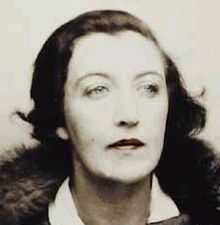Dorothy Wilde
| Dolly Wilde | |
|---|---|
 | |
| Born |
Dorothy Ierne Wilde 11 July 1895 London |
| Died |
April 10, 1941 (aged 45) England |
| Nationality | British |
| Occupation | Socialite |
Dorothy Ierne Wilde, known as Dolly Wilde, (July 11, 1895 – April 10, 1941) was an Anglo-Irish socialite, made famous by her family connections and her reputation as a witty conversationalist. Her charm and humor made her a popular guest at salons in Paris between the wars, standing out even in a social circle known for its flamboyant talkers.
Life
Wilde, born in London three months after her uncle Oscar Wilde's arrest for homosexual acts, was the only child of Oscar's older brother, Willie. Her father died just a few years later, and she was raised by her mother and her stepfather, the translator Alexander Teixeira de Mattos.
In 1914, she travelled to France in order to drive an ambulance in World War I. About 1917 or 1918, while both were living in Paris, she had an affair with one of her fellow ambulance drivers, Standard Oil heiress Marion "Joe" Carstairs, who in the 1920s became a speedboat racer and was known as "the fastest woman on water."[1] Although she "revelled in" attracting both men and women, Wilde was primarily, if not entirely, lesbian.[2]
Wilde drank to excess and was addicted to heroin. She went through several detoxification attempts, none successful; she emerged from one nursing-home stay with a new dependency on the sleeping draught paraldehyde, then available over-the-counter.[3]
In 1939 she was diagnosed with breast cancer and refused surgery, seeking alternative treatments.[4] The following year, with the Germans approaching Paris, she fled for England.[5] She died aged 45 in 1941, of "causes unascertainable", according to the coroner's inquest—possibly the cancer or possibly a drug overdose.[6]
Relationship with Natalie Barney
Her longest relationship, lasting from 1927 until her death, was with openly lesbian American writer Natalie Clifford Barney, who was host of one of the best-known Parisian literary salons of the 20th century.[7]
Due in part to Jean Chalon's early biography of her, published in English as Portrait of a Seductress, Natalie Barney has become more widely known for her many relationships than for her writing or her salon.[8] She once wrote out a list, divided into three categories: liaisons, demi-liaisons, and adventures.
Writing
Dolly Wilde was regarded by many as a gifted storyteller and writer, but she never took advantage of these natural talents. She was supported mostly by the generosity of others and by a small inheritance from her stepfather; her only written works were translations—often uncredited and unpaid—and animated correspondence with her friends.
References
- ↑ Schenkar, Joan (2000). Truly Wilde: The Unsettling Story of Dolly Wilde, Oscar's Unusual Niece. New York: Basic Books. pp. 86–88. ISBN 0-465-08772-8.
- ↑ Schenkar, 124.
- ↑ Schenkar, 280-293.
- ↑ Schenkar, 269.
- ↑ Rodriguez, 318.
- ↑ Schenkar, 37-48.
- ↑ Rodriguez, Suzanne (2002). Wild Heart: A Life: Natalie Clifford Barney and the Decadence of Literary Paris. New York: HarperCollins. ISBN 0-06-093780-7.
- ↑ "I would be asked at dinner parties what I was working on and, replying, 'Natalie Clifford Barney,' I expected the usual post Jean Chalon response, 'What? The lesbian Don Juan?'" Livia (1992), 181.
External links
- Biography of Wilde in the New York Times
- When Wilde's lover Natalie Barney met her uncle Oscar Wilde
|